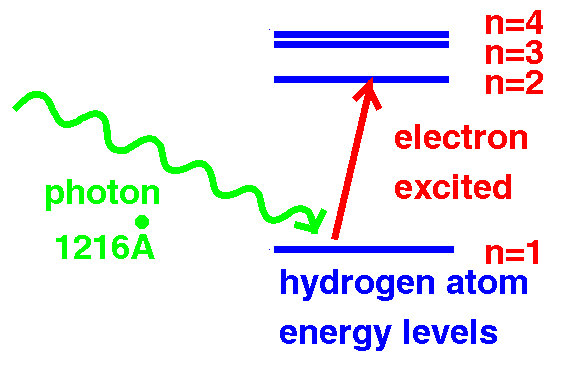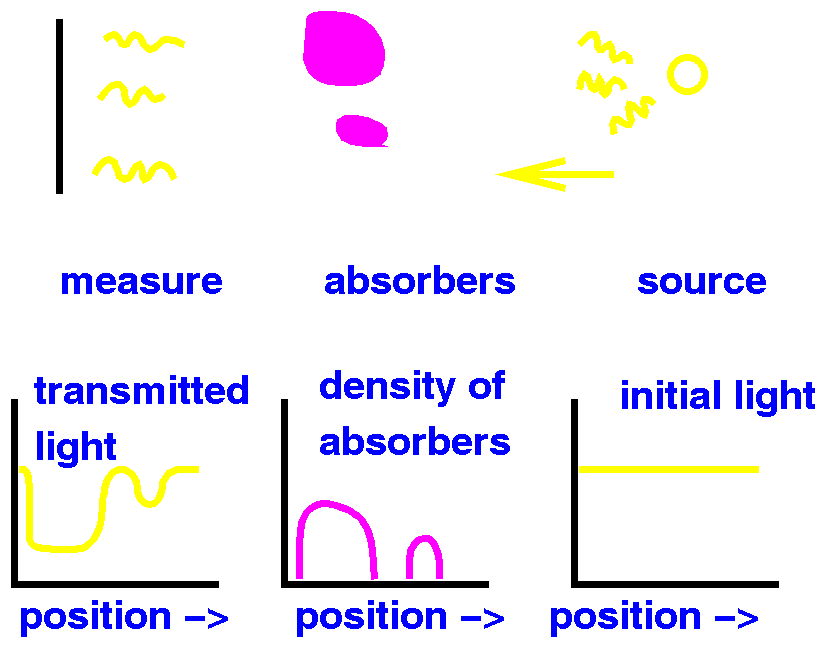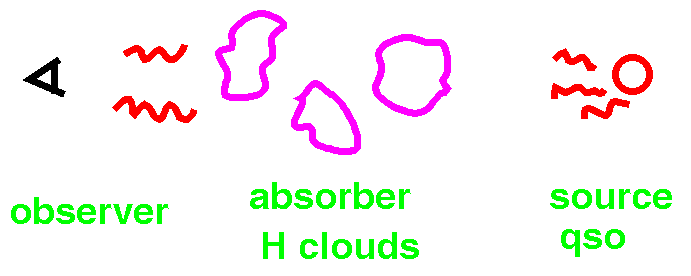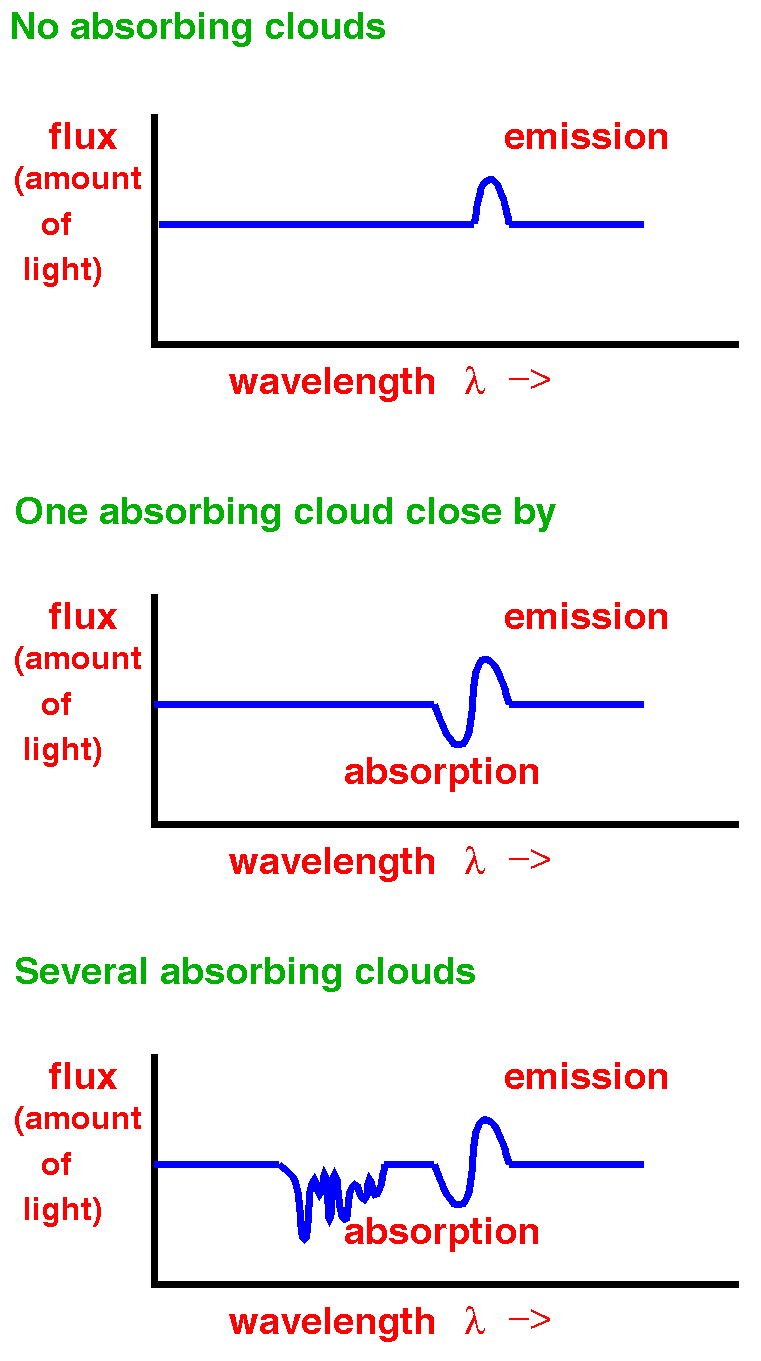Lyman alpha systems and cosmology
Lyman alpha systems are becoming a very useful source of information
in physical cosmology.
The Lyman series is the series of energies required
to excite an electron in hydrogen from its
lowest energy state to a higher energy state.
 The case of particular interest for cosmology is where a
a hydrogen atom with its electron in the lowest
energy configuration gets hit by a photon (light wave) and
is boosted to the next lowest energy level.
The energy levels are given by
En = -13.6 eV/n2
and the energy difference between the lowest (n=1) and
second lowest(n=2) levels corresponds to a photon with
wavelength 1216 angstroms.
The reverse process can and does occur as well, where an
electron goes from the higher n=2 energy state to the ground
state, releasing a photon of the same energy.
The case of particular interest for cosmology is where a
a hydrogen atom with its electron in the lowest
energy configuration gets hit by a photon (light wave) and
is boosted to the next lowest energy level.
The energy levels are given by
En = -13.6 eV/n2
and the energy difference between the lowest (n=1) and
second lowest(n=2) levels corresponds to a photon with
wavelength 1216 angstroms.
The reverse process can and does occur as well, where an
electron goes from the higher n=2 energy state to the ground
state, releasing a photon of the same energy.
 The absorption or emission of photons with the correct
wavelength can tell us something about the presence of hydrogen
and free electrons in space.
That is, if you shine a light
with wavelength 1216 at a bunch of neutral hydrogen atoms in
their ground state, the atoms will
absorb the light, using it to boost the electron to a higher energy state.
If there are a lot of neutral hydrogen atoms in their ground state, they will
absorb more and more of the light.
So if you look at the light you receive, intensity as a function
of wavelength, you will see a dip in the intensity at 1216 angstroms,
depending on the amount of neutral hydrogen present in its ground state.
The amount of light absorbed ('optical depth')
is proportional to the probability that the hydrogen will absorb
the photon (cross section) times the number of hydrogen atoms
along its path.
The absorption or emission of photons with the correct
wavelength can tell us something about the presence of hydrogen
and free electrons in space.
That is, if you shine a light
with wavelength 1216 at a bunch of neutral hydrogen atoms in
their ground state, the atoms will
absorb the light, using it to boost the electron to a higher energy state.
If there are a lot of neutral hydrogen atoms in their ground state, they will
absorb more and more of the light.
So if you look at the light you receive, intensity as a function
of wavelength, you will see a dip in the intensity at 1216 angstroms,
depending on the amount of neutral hydrogen present in its ground state.
The amount of light absorbed ('optical depth')
is proportional to the probability that the hydrogen will absorb
the photon (cross section) times the number of hydrogen atoms
along its path.
 Because the universe has many high energy photons and hydrogen atoms,
both the absorption and emission of photons occurs frequently.
In Lyman alpha systems, the hydrogen is found in regions in
space, and the source for the photons are quasars (also called
qsos), very high
energy light sources, shining at us from behind these regions.
Because the universe has many high energy photons and hydrogen atoms,
both the absorption and emission of photons occurs frequently.
In Lyman alpha systems, the hydrogen is found in regions in
space, and the source for the photons are quasars (also called
qsos), very high
energy light sources, shining at us from behind these regions.
 Because the universe is
expanding, one can learn more than just the number of
neutral hydrogen atoms between us and the quasar.
As these photons travel to us, the universe expands, stretching out
all the light waves. This increases the wavelengths
lambda
and lowers the energies of the photons (`redshifting').
Because the universe is
expanding, one can learn more than just the number of
neutral hydrogen atoms between us and the quasar.
As these photons travel to us, the universe expands, stretching out
all the light waves. This increases the wavelengths
lambda
and lowers the energies of the photons (`redshifting').
Neutral hydrogen atoms in their lowest state will interact with whatever
light has been redshifted to a wavelength of 1216 angstroms when it
reaches them. The rest of the light will keep travelling
to us.
The quasar shines with a certain spectrum or distribution of energies,
with a certain amount of power in each wavelength.
 At right, the top picture shows a cartoon of how a quasar spectrum
(the flux of light as a function of wavelength)
might look if there were no intervening
neutral hydrogen between the qso and us.
In reality, gas around the quasar both emits and absorbs photons.
With the presence of neutral hydrogen, including that near the
quasar, the emitted flux is depleted for certain wavelengths, indicating
the absorption by this intervening neutral hydrogen.
As the 1216 wavelength is preferably absorbed, we know that
at the location the photon is absorbed, its wavelength is probably
1216 angstroms. Its wavelength was stretched by the expansion of the universe
from what it was initially at the quasar, and, if it had continued
to travel to us, it would have been stretched some more from the
1216 angstroms wavelength it had at the absorber. Thus
we see the dip in flux at the wavelength corresponding to that
which the 1216 angstrom (when it was absorbed) photon
would have had if it had reached us.
As we can calculate how the universe is expanding,
we can tell where the photons were absorbed in relation to us.
Thus one can use the absorption map to plot the positions of region
of intervening hydrogen between us and the quasar.
The middle picture at right shows the flux for one nearby region while
the bottom picture shows the case for several intervening regions.
At right, the top picture shows a cartoon of how a quasar spectrum
(the flux of light as a function of wavelength)
might look if there were no intervening
neutral hydrogen between the qso and us.
In reality, gas around the quasar both emits and absorbs photons.
With the presence of neutral hydrogen, including that near the
quasar, the emitted flux is depleted for certain wavelengths, indicating
the absorption by this intervening neutral hydrogen.
As the 1216 wavelength is preferably absorbed, we know that
at the location the photon is absorbed, its wavelength is probably
1216 angstroms. Its wavelength was stretched by the expansion of the universe
from what it was initially at the quasar, and, if it had continued
to travel to us, it would have been stretched some more from the
1216 angstroms wavelength it had at the absorber. Thus
we see the dip in flux at the wavelength corresponding to that
which the 1216 angstrom (when it was absorbed) photon
would have had if it had reached us.
As we can calculate how the universe is expanding,
we can tell where the photons were absorbed in relation to us.
Thus one can use the absorption map to plot the positions of region
of intervening hydrogen between us and the quasar.
The middle picture at right shows the flux for one nearby region while
the bottom picture shows the case for several intervening regions.
It is common to see a series of absorption lines, called
the Lyman alpha forest.
Systems which are slightly more dense,
Lyman limit systems, are
thick enough that radiation doesn't get into their interior.
Inside these regions there is some neutral hydrogen remaining,
screened by the outer region layers.
If the regions are very thick,
there is instead a wide trough in the absorption, and one has
a damped Lyman alpha system.
Absorption lines generally aren't just at one fixed wavelength, but over
a range of wavelengths, with a width and intensity (line shape) determined
in part by the lifetime of the excited n=2 hydrogen atom state.
These
damped Lyman alpha systems have enough absorption
to show details of the line shape such as that determined by
the lifetime of the excited state.
These dense
clumps are thought to have something to do with galaxies that are forming.
One can use the ionization of neutral hydrogen to find galaxies as
well, for example the Lyman break systems described in
these technical conference
proceedings.
There is a very cool visualization of how different systems absorb Lyman-alpha
here by
Andrew Pontzen.
Some numbers:
- How dense are the Lyman alpha forest systems (column densities)?
1014 atoms per square centimeter.
Lyman limit systems are 103 times denser and damped
Lyman alpha systems another factor of 103 times more.
- How far away are the quasar sources?
To be observed from the ground, the Lyman alpha wavelength needs
to be stretched by factors of 3 to 5. The amount
of "stretching" is related to redshift z by
stretch = (z +1). So ground observed sources have redshifts z of 2-4.
A qso with redshift of z=2 emitted its light when the universe was
less than about 1/4 of its current age (that is, about 1/4 of
13 billion years or so), while at redshift z=4 we are seeing objects from when
the universe was less than 1/10 of its current age.
- How many systems are expected in upcoming surveys?
Large statistical samples which have been publicly relased
include the 2dF-SDSS quasar survey (2SLAQ)
SDSS and the SDSS Quasar catalogue (latest releast spring 2010
abstract is here with
105783 quasars).
Currently, BOSS is
underway to produce Lyman-alpha forest spectra of 160,000 quasars at
redshifts 2.2
Uses:
We learn several things from these systems, including the following.
- Neutral hydrogen: because we see any light at
all, we can limit how much neutral hydrogen is out there between us and
the quasar and what its distribution is.
It used to be thought that there was a smooth intergalactic
medium (IGM) with regions embedded in it, and the smooth background
would provide an absorption at all positions between us and
the quasar (Gunn-Peterson effect). But observers only see evidence of
lumpy regions. There isn't evidence for a spatially smooth
component of neutral hydrogen between us and the quasar sources.
It is a question of active research what is making the amount of neutral
hydrogen so small (that is, what is ionizing the rest of the hydrogen).

- Structure formation:
the regions in the
Lyman alpha systems are not very massive compared to objects like
galaxies. As a result, reliable computer
simulations (numerical experiments) of their gravitational
collapse (formation) from primoridal fluctuations are possible.
Until the 90's, it was thought that gravity alone could not form
all the structure, in particular the filaments, walls, and voids which we observe.
However,
the Lyman alpha simulations did produce this structure by starting with
small fluctuations in matter density and then letting
gravity and other known forces act. It was not necessary to add other
mechanisms to get the observed structure in these systems.
The detailed properties of the structure and distribution of matter
are frontiers of current research. At right is
a picture of the distribution of neutral hydrogen found in
simulations.
- Hot dark matter:
The numerical simulations have also shown, via their successful reproduction
of properties of the regions, that one cannot have too much
hot dark matter
if one wants to agree with observations. (Too much hot dark matter
erases structure on small scales.)
- Distribution of matter:
The Lyman alpha
regions are formed by gas falling into gravitational potential
wells of all the matter, not just the luminous matter. So they provide
another tracer of
dark matter.
- Nucleosynthesis: deuterium is produced in
'the first three minutes' in the early universe, and afterwards is
believed to only be destroyed.
The Lyman alpha systems have deuterium in them too, and as these systems also
have low amounts of metals (heavier elements), one might hope that they
are measuring unprocessed or primordial deuterium. The deuterium also
absorbs light from quasars, and thus its abundance can be
measured in a similar way.
Searches in many of these systems have provided the
current strongest constraint on
the amount of primoridal deuterium and thus the baryon density in the
universe. See this
link
or this
poster on big bang nucleosynthesis.
- Cosmological constant: the path back
to a given redshift depends on how the universe has expanded since that
time. The angular extent of an object at any redshift also
depends on the expansion of the universe since the light was emitted, but
in a different way. Thus one can compare angular and radial (more precisely
redshift) lengths for objects. If one knows the expected ratio of
these lengths for an object for other reasons, one can constrain the
expansion history of the universe, in particular the cosmological constant.
A variant of this
Alcock Pacynzski test involves tracing lines of sight through
the Lyman alpha regions for neighboring quasars.
Further reading:
- Lya notes by
M. White (~2005) for reading group at UC Berkeley
-
"The Lyman-alpha Forest as a Cosmological Tool",
David H. Weinberg, Romeel Dav'e, Neal Katz, Juna A. Kollmeier,
AIP Conf.Proc. 666 (2003) 157-169
- "Shadows of Creation: Quasar Absorption Lines and the Genesis of
Galaxies," Jill Bechtold, Sky and Telescope, Sept. 1997
- Perspectives in Astrophysical Cosmology, by Martin Rees,
Cambridge University Press, pp. 88-94.
-
Lecture notes by D. Weinberg on QSO absorption lines and the IGM
-
Lecture notes by D. Weinberg on Cosmology with the Ly-alpha forest
Back to
theoretical cosmology
Please send suggestions to
jcohn@berkeley.edu,
thanks to M. White and L. Hernquist for suggestions and figures.
 The case of particular interest for cosmology is where a
a hydrogen atom with its electron in the lowest
energy configuration gets hit by a photon (light wave) and
is boosted to the next lowest energy level.
The energy levels are given by
En = -13.6 eV/n2
and the energy difference between the lowest (n=1) and
second lowest(n=2) levels corresponds to a photon with
wavelength 1216 angstroms.
The reverse process can and does occur as well, where an
electron goes from the higher n=2 energy state to the ground
state, releasing a photon of the same energy.
The case of particular interest for cosmology is where a
a hydrogen atom with its electron in the lowest
energy configuration gets hit by a photon (light wave) and
is boosted to the next lowest energy level.
The energy levels are given by
En = -13.6 eV/n2
and the energy difference between the lowest (n=1) and
second lowest(n=2) levels corresponds to a photon with
wavelength 1216 angstroms.
The reverse process can and does occur as well, where an
electron goes from the higher n=2 energy state to the ground
state, releasing a photon of the same energy.
 The absorption or emission of photons with the correct
wavelength can tell us something about the presence of hydrogen
and free electrons in space.
That is, if you shine a light
with wavelength 1216 at a bunch of neutral hydrogen atoms in
their ground state, the atoms will
absorb the light, using it to boost the electron to a higher energy state.
If there are a lot of neutral hydrogen atoms in their ground state, they will
absorb more and more of the light.
So if you look at the light you receive, intensity as a function
of wavelength, you will see a dip in the intensity at 1216 angstroms,
depending on the amount of neutral hydrogen present in its ground state.
The amount of light absorbed ('optical depth')
is proportional to the probability that the hydrogen will absorb
the photon (cross section) times the number of hydrogen atoms
along its path.
The absorption or emission of photons with the correct
wavelength can tell us something about the presence of hydrogen
and free electrons in space.
That is, if you shine a light
with wavelength 1216 at a bunch of neutral hydrogen atoms in
their ground state, the atoms will
absorb the light, using it to boost the electron to a higher energy state.
If there are a lot of neutral hydrogen atoms in their ground state, they will
absorb more and more of the light.
So if you look at the light you receive, intensity as a function
of wavelength, you will see a dip in the intensity at 1216 angstroms,
depending on the amount of neutral hydrogen present in its ground state.
The amount of light absorbed ('optical depth')
is proportional to the probability that the hydrogen will absorb
the photon (cross section) times the number of hydrogen atoms
along its path.
 Because the universe has many high energy photons and hydrogen atoms,
both the absorption and emission of photons occurs frequently.
In Lyman alpha systems, the hydrogen is found in regions in
space, and the source for the photons are quasars (also called
qsos), very high
energy light sources, shining at us from behind these regions.
Because the universe has many high energy photons and hydrogen atoms,
both the absorption and emission of photons occurs frequently.
In Lyman alpha systems, the hydrogen is found in regions in
space, and the source for the photons are quasars (also called
qsos), very high
energy light sources, shining at us from behind these regions.
 Because the universe is
Because the universe is
 At right, the top picture shows a cartoon of how a quasar spectrum
(the flux of light as a function of wavelength)
might look if there were no intervening
neutral hydrogen between the qso and us.
In reality, gas around the quasar both emits and absorbs photons.
With the presence of neutral hydrogen, including that near the
quasar, the emitted flux is depleted for certain wavelengths, indicating
the absorption by this intervening neutral hydrogen.
As the 1216 wavelength is preferably absorbed, we know that
at the location the photon is absorbed, its wavelength is probably
1216 angstroms. Its wavelength was stretched by the expansion of the universe
from what it was initially at the quasar, and, if it had continued
to travel to us, it would have been stretched some more from the
1216 angstroms wavelength it had at the absorber. Thus
we see the dip in flux at the wavelength corresponding to that
which the 1216 angstrom (when it was absorbed) photon
would have had if it had reached us.
As we can calculate how the universe is expanding,
we can tell where the photons were absorbed in relation to us.
Thus one can use the absorption map to plot the positions of region
of intervening hydrogen between us and the quasar.
The middle picture at right shows the flux for one nearby region while
the bottom picture shows the case for several intervening regions.
At right, the top picture shows a cartoon of how a quasar spectrum
(the flux of light as a function of wavelength)
might look if there were no intervening
neutral hydrogen between the qso and us.
In reality, gas around the quasar both emits and absorbs photons.
With the presence of neutral hydrogen, including that near the
quasar, the emitted flux is depleted for certain wavelengths, indicating
the absorption by this intervening neutral hydrogen.
As the 1216 wavelength is preferably absorbed, we know that
at the location the photon is absorbed, its wavelength is probably
1216 angstroms. Its wavelength was stretched by the expansion of the universe
from what it was initially at the quasar, and, if it had continued
to travel to us, it would have been stretched some more from the
1216 angstroms wavelength it had at the absorber. Thus
we see the dip in flux at the wavelength corresponding to that
which the 1216 angstrom (when it was absorbed) photon
would have had if it had reached us.
As we can calculate how the universe is expanding,
we can tell where the photons were absorbed in relation to us.
Thus one can use the absorption map to plot the positions of region
of intervening hydrogen between us and the quasar.
The middle picture at right shows the flux for one nearby region while
the bottom picture shows the case for several intervening regions.
